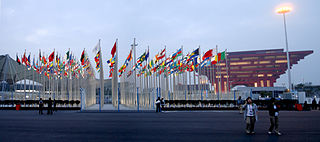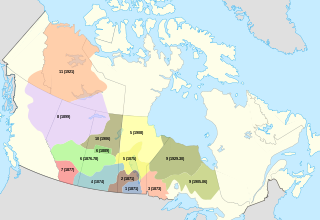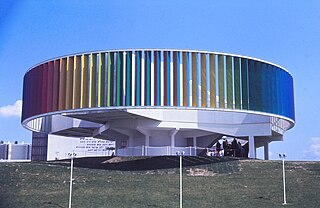
The 1967 International and Universal Exposition or Expo 67, as it was commonly known, was a general exhibition, Category One World's Fair held in Montreal, Quebec, Canada, from April 27 to October 29, 1967. It is considered to be the most successful World's Fair of the 20th century with the most attendees to that date and 62 nations participating. It also set the single-day attendance record for a world's fair, with 569,500 visitors on its third day.

The Bureau international des expositions is an intergovernmental organization created to supervise international exhibitions falling under the jurisdiction of the Convention Relating to International Exhibitions.

Expo 2000 was a World Expo held in Hanover, Germany from Thursday 1 June to Tuesday 31 October 2000. It was located on the Hanover Fairground, which is the largest exhibition ground in the world. Initially some 40 million people were expected to attend the exhibition over the course of months; however, eventually with less than half of this number, the Expo was a flop and turned out to be a financial failure.

"Vive le Québec libre!" was a phrase in a speech delivered by French President Charles de Gaulle in Montreal, Quebec on July 24, 1967, during an official visit to Canada for the Expo 67 world's fair. While giving an address to a large crowd from a balcony at Montreal City Hall, he uttered "Vive Montréal ! Vive le Québec !" and then added, followed by loud applause, "Vive le Québec libre !" with particular emphasis on the word libre. The phrase, a slogan used by Quebecers who favoured Quebec sovereignty, was seen as giving his support to the movement. The speech caused a diplomatic incident with the Government of Canada and was condemned by Canadian Prime Minister Lester B. Pearson, saying that "Canadians do not need to be liberated". In France, though many were sympathetic to the cause of Quebec nationalism, De Gaulle's speech was criticized as a breach of protocol.
"A Place to Stand, a Place to Grow" (Ontari-ari-ari-o!) is the unofficial provincial anthem of the Canadian province of Ontario. It was written as the signature tune for a movie of the same name that was featured at the Expo 67 Ontario pavilion.
Treaty Five is a treaty that was first established in September, 1875, between Queen Victoria and Saulteaux and Swampy Cree non-treaty band governments and peoples around Lake Winnipeg in the District of Keewatin. Much of what is today central and northern Manitoba was covered by the treaty, as were a few small adjoining portions of the present-day provinces of Saskatchewan and Ontario. The Treaty was completed in two rounds. The first was from September 1875 to September 1876. The Crown intended in 1875 to include only "the Indians [east and west] of Lake Winnipeg for the surrender of the Territory uncovered by previous treaties" including "the proposed migration of the Norway House band". Pimicikamak territory was north of the lake. It was included by accident or design of Tepastenam attending the Norway House signing. Additional peoples and groups signed on between 1908 and 1910.
The association between the Canadian Crown and Indigenous peoples in Canada stretches back to the first decisions between North American Indigenous peoples and European colonialists and, over centuries of interface, treaties were established concerning the monarch and Indigenous nations. First Nations, Inuit, and Métis peoples in Canada have a unique relationship with the reigning monarch and, like the Māori and the Treaty of Waitangi in New Zealand, generally view the affiliation as being not between them and the ever-changing Cabinet, but instead with the continuous Crown of Canada, as embodied in the reigning sovereign. These agreements with the Crown are administered by Canadian Aboriginal law and overseen by the Minister of Indigenous and Northern Affairs.

The Expo 67 International and Universal Exposition featured 90 pavilions representing Man and His World, on a theme derived from Terre des Hommes, written by the famous French pilot Antoine de Saint-Exupéry.

Expo 2012 Yeosu Korea was an International Exposition recognised by the Bureau International des Expositions (BIE) held in Yeosu, South Korea which opened May 12, 2012 and ran until August 12, 2012. The theme of the Expo was "The Living Ocean and Coast" with subthemes of "Preservation and Sustainable Development of the Ocean and Coast", "New Resources Technology", and "Creative Marine Activities". There were 105 participating countries, international organizations, and 8,203,956 visitors.

The Aboriginal Peoples Television Network is a Canadian specialty channel. Established in 1992 and maintained by governmental funding to broadcast in Canada's northern territories, APTN acquired a national broadcast licence in 1999. It airs and produces programs made by, for and about Indigenous peoples in Canada and the United States. Based in Winnipeg, Manitoba, it is the first network by and for North American indigenous peoples.

The Red Pheasant Cree Nation is a Plains Cree First Nations band government in the Canadian province of Saskatchewan. The band's sole reserve, Red Pheasant 108, is 33 km (21 mi) south of North Battleford.
Jackson Beardy was an Indigenous Anishinaabe artist born in Canada. His works are characterized by scenes from Ojibwe and Cree oral traditions and many focus on the relationship between humans and nature. He belonged to the Woodland School of Art and was a prominent member of the Indian Group of Seven. His work has contributed to the recognition of Indigenous contemporary art within Canada.
Challenge for Change was a participatory film and video project created by the National Film Board of Canada in 1967, the Canadian Centennial. Active until 1980, Challenge for Change used film and video production to illuminate the social concerns of various communities within Canada, with funding from eight different departments of the Canadian government. The impetus for the program was the belief that film and video were useful tools for initiating social change and eliminating poverty. As Druik says, "The new program, which was developed in tandem with the new social policies, was based on the argument that participation in media projects could empower disenfranchised groups and that media representation might effectively bring about improved political representation." Stewart, quoting Jones (1981) states "the Challenge for Change films would convey messages from 'the people' to the government, directly or through the Canadian public."
The following is an alphabetical list of topics related to Indigenous peoples in Canada, comprising the First Nations, Inuit and Métis peoples.

This article contains the details of the pavilions in Expo 2010. The 2010 World Expo Shanghai is the largest Expo site ever, covering more than 5.2 square kilometres and containing more than 70 exposition pavilions. More than 190 countries and 50 international organizations registered to participate in the 2010 Shanghai Expo. After the six-month run, the Expo had attracted well over 70 million visitors. The Expo 2010 is also the most expensive fair in the history of World's Fair, with more than 45 billion US dollars invested from the Chinese Government.

The Québec Pavilion at Expo 67 in Montreal was a steel and glass frustum structure built above a body of water between the Ontario and French Pavilions on Notre Dame Island.
Although same-sex sexual activity was illegal in Canada up to 1969, gay and lesbian themes appear in Canadian literature throughout the 20th century. Canada is now regarded as one of the most advanced countries in legal recognition of lesbian, gay, bisexual, and transgender (LGBT) rights.

The Michel Band is an Indigenous nation of central Alberta, Canada which the Government of Canada recognized as a nation and treaty partner from 1878 to 1958. The descendents of that historic band, now organized as an association called the Michel First Nation, are engaged in legal and political action to regain recognition.
Skawennati is a Mohawk multimedia artist, best known for her online works as well as Machinima that explore contemporary Indigenous cultures, and what Indigenous life might look like in futures inspired by science fiction. She served as the 2019 Indigenous Knowledge Holder at McGill University. In 2011, she was awarded an Eiteljorg Contemporary Art Fellowship which recognized her as one of "the best and most relevant native artists."

The Kaleidoscope Pavilion was a sponsored pavilion at Expo 67, the International World's Fair held in Montreal, Quebec, Canada in 1967.












